[shop for Dynafit ski touring gear]
Ok girls and boys, I’ll just go through the line with emphasis on the new (leaving skis for later).
First, the new boots. Last year Dynafit introduced their Dy.N.A (DNA) race boot, a feather weight form-fitting shoe with a small amount of metatarsal flex. At the time, friends and I looked at the DNA and said “we want something like that for touring.” The DNA’s tiny amount of forefoot flex isn’t an issue for binding performance and may enhance comfort and efficiency, the lack of weight is terrific, and the boot’s two buckle (including lean lock) closure system is simple and quick. It also has a very short sole for a given size, which adds even more comfort and efficiency.
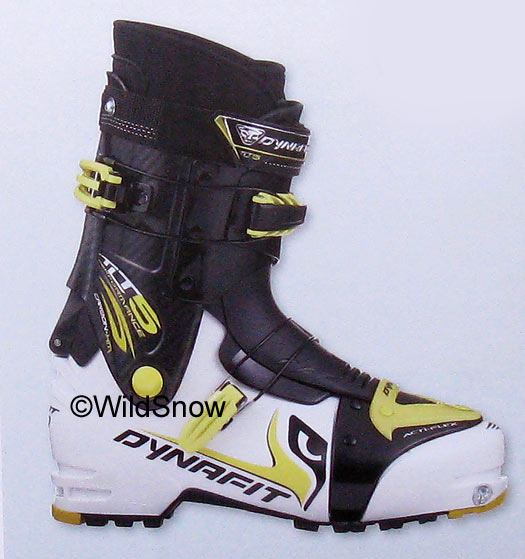
NEW for 2010/2011, Dynafit TLT 5 Performance backcountry skiing boot. The shell tongue is easily removable for less weight and more comfort in touring mode. You can carry the tongues in your pack and place in the boot for the down, or just leave them in the boots.
The Dynafit DNA race boot lacks a plastic shell tongue, so you just ski them downhill rigid and locked. That’s fine for rando racing when you’re simply trying to get down the mountain as fast as possible, but it is not the sweeter flex you want for casual touring turns. The DNA (Dy. N. A.) boot is also quite expensive.
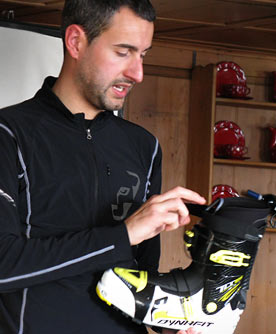
Italian boot craftsman/engineer Federico Sbrissa explains the Dynafit TLT 5 to our weiss beer ransomed ears.
So this year Dynafit is introducing their “TLT 5” ski touring backcountry skiing boots based on the DNA platform, only optimized for both up and down (mostly, they added an easily removable plastic shell tongue you can carry in your backpack, leave on the boot, or leave at home).
Top of the TLT5 line (pictured above and to right) is their TLT5 Performance TF with a carbon fiber cuff and thermo liner (probably around $900 MSRP unless the overvalued euro gets an adjustment — yes, we can always hope.)
For around $200 less coin and a bit more weight, Dynafit also offers the TLT 5 Mountain TF, main difference being a regular plastic cuff instead of carbon fiber.
TLT 5 Performance weighs about 1,115 grams with tongue, TLT 5 Mountain weighs about 1,125 grams with tongue. That’s very light, and they have a sweet touring flex. Repeat, these boots could very well be some of the best footwear yet for human powered skiing.
For details on how the TLT 5 works, you can check our Dy. N. A. race boot review from last year, as all functions and parameters are nearly the same.
Dynafit’s climbing skins remain similar to last year’s, with their proprietary fixation system using an elastic nub that fits in the slot on any Dynafit brand ski tip. While this system works 99% of the time and is easy to apply, the elastic can come off at the ski tip if your skin stretches. Still, I use this rig quite a bit and give it a pass — the key is to make sure the elastic fits tautly. The company also sells race mohair on rolls, though it’s not certain what will be imported to North America. If you’re in a group that likes mohair and skis lots of miles, getting a roll of skins can make things much more affordable.
Other than developments in the race grabber we blogged yesterday, Dynafit’s binding line remains little changed. Both the FT 12 (now called the FT Z12) and Vertical ST are available in both gray and white color schemes (my guess is they had a military contract for some white ones, and figured why not stick them in the catalog for those needing something in white to go with their white one-piece suit?).
The classic TLT Speed will still be available (basically the original mainstream production Dynafit, main advantages some cost and weight savings, but they don’t work as well for aggressive skiing as the ST/FT offerings.) Dynafit is also making the TLT in a green limited edition, to go with the green scheme of their Broad Peak ski, a new plank for extreme skiing (stiff, 112/74/96) that I’m allowed to blog about. This could be a good board for steep icy ski descents if that sort of thing is your bag, but it’s not that interesting to us here at WildSnow HQ.
Also in bindings, worth mentioning that Dynafit will have a budget race binding available, basically a TLT toe with one of the new race heels, at 197 grams compared to TLT Speed at 335 grams. Not sure if this will be imported, but it looks like a good option if you want to save significant foot weight without buying the super expenso version. (See yesterday’s blog for more info about the race bindings and such.)
Get your Dynafit bindings here.
Moving along, one of the cooler new things is a “Speed” crampon with shorter teeth. Lighter weight, easier to pack.
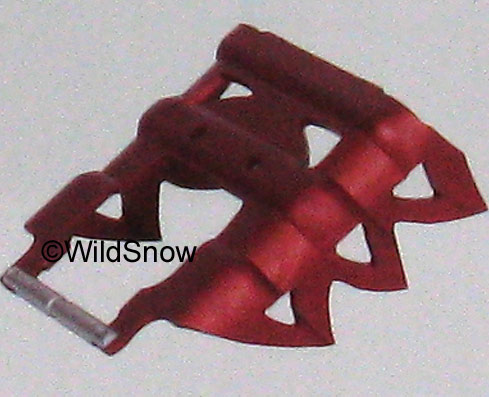
Dynafit Speed ski crampon.
While the Speed Crampon was developed with races such as Mountain Attack in mind (steep icy sections), the concept is good for times that you’re carrying ski crampons more for icy conditions than for firm snow. Of course the shorter teeth mean you won’t be using your higher heel lift — but you don’t really want to be teetering on stilts in a glacier ice field anyway. Only available in one skinny width, so that could be an issue.
Buy Dynafit ski crampons here.
If you like using bindings without ski brakes, how to leash a Dynafit is always the question. B&D Ski Gear (see ad to left) has addressed that question, and you can easily homebrew good solutions. But it’s nice that Dynafit is offering a leash that looks functional and easy to modify, and has some binding adjustment tools built in.
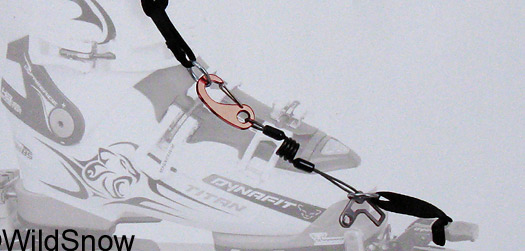
Dynafit binding ski leash is ready to modify to your own specifications.
At the European press event each year, they spend quite a bit of time going through the Dynafit clothing line. I’ve really liked this stuff since they first launched, but the super slim fit can be an issue, and you never know what pieces will be imported to North America. Nonetheless, if you’ve got an athletic build and want some clothing that is truly built specific to backcountry skiing, I encourage you to take a look.
Truth: I’d be perfectly happy to dress in Dynafit from my gloves all the way down to my base layer — their apparel is that good.
New this year in Dynafit clothing are some nice merino/synthetic blend base layers. A 3/4 length long underwear looks good, as does their men’s short. Same stuff for the women as well. Layering out from there, they’ve got soft shells, down or Primaloft puffs, and tons (or, in the case of Dynafit, grams) more finery. Let’s see what they’re going to bring in and we’ll base a more detailed review on that.
Oh yeah, I should also mention that Dynafit’s “Storm” overglove is a great concept for speedy athletic backcountry skiing. The idea is you wear this Primaloft insulated mitten with a light liner glove, and a window in the palm allows you to quickly stick your fingers out to manipulate cameras and that sort of thing.
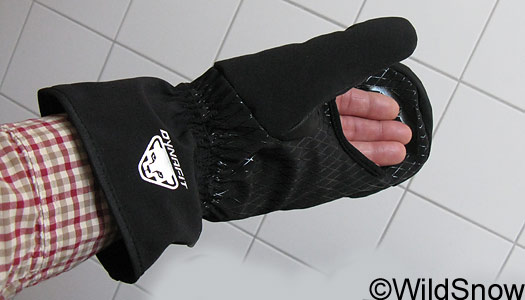
Dynafit's Storm overglove has a large window in the palm. Not ideal for extreme conditions, but perfect for photography during moderate trips and that sort of thing.
Having a finger window in your mitten palm isn’t a particularly new concept, but this one is executed in such a way as to be less bulky and more easily accessed than most. Downside is the window is always open, so this isn’t the mitten for hardcore trips where you’re dealing with hours and hours of desperate cold and snow. It’s more for the in-between times.
If Dynafit’s new SSS ski pole works as promised it could revolutionize the adjustable pole market.
As far as I know, all adjustable ski poles up to this juncture work with friction. Before flicklock mechanisms, you had to twist a compression fitting — which sometimes worked — the operative word being “sometimes.” Things were much improved when Black Diamond introduced their Flicklock system, which became the standard by which all other adjustable ski poles are judged (at least they were here, anyway). But nothing is perfect, and flicklock mechanisms still require adjustment, can collapse when heavily weighted, and so forth.
Instead of friction, the SSS ski pole lock works with a system of small notches and a cam. The cam forces a pawl into a given notch, tightens things up, and you end up with a super solid adjustable pole.
Bear in mind that the SSS system has not been independently tested to any great extent, so don’t go hog wild on it yet. But once the mechanism is vetted I’m thinking this might be super nice. Not sure what the downsides would be — I guess we’ll just have to find out.
Last gear in this review: ski touring backpacks. While Dynafit’s packs of course lack the ever essential Black Diamond Avalung or an avalanche airbag system, they’re still a viable option if you don’t feel any particular need for an avalanche safety device built into your rucksack. Of particular interest are their lightweight Broad Peak (28 liters) and RC 20 (20 liters) models.
What I like best about these packs is they ride a bit lower and closer to your back than some other models/brands. More, they really don’t compromise on reducing mass, and they have an excellent diagonal ski carry system that comes ready from the factory for clipping skis on and off without removing your pack.
All Dynafit backpacks have what my friends here and I are calling the “pastry box,” which is a horizontal storage compartment at the base of the pack you can access by reaching behind and pulling a velcro flap (which is spring loaded, so you won’t leave it accidentally open). You can store a rope in here, or your crampons, or a puffy. Kind of one step beyond just zipping open a panel loader or digging through a top loader.
That’s it for now, more later and of course I’ll soon start running some trip reports from the Tirol, the heartland of alpine ski touring!
[shop for Dynafit ski touring gear]
WildSnow.com publisher emeritus and founder Lou (Louis Dawson) has a 50+ years career in climbing, backcountry skiing and ski mountaineering. He was the first person in history to ski down all 54 Colorado 14,000-foot peaks, has authored numerous books about about backcountry skiing, and has skied from the summit of Denali in Alaska, North America’s highest mountain.
